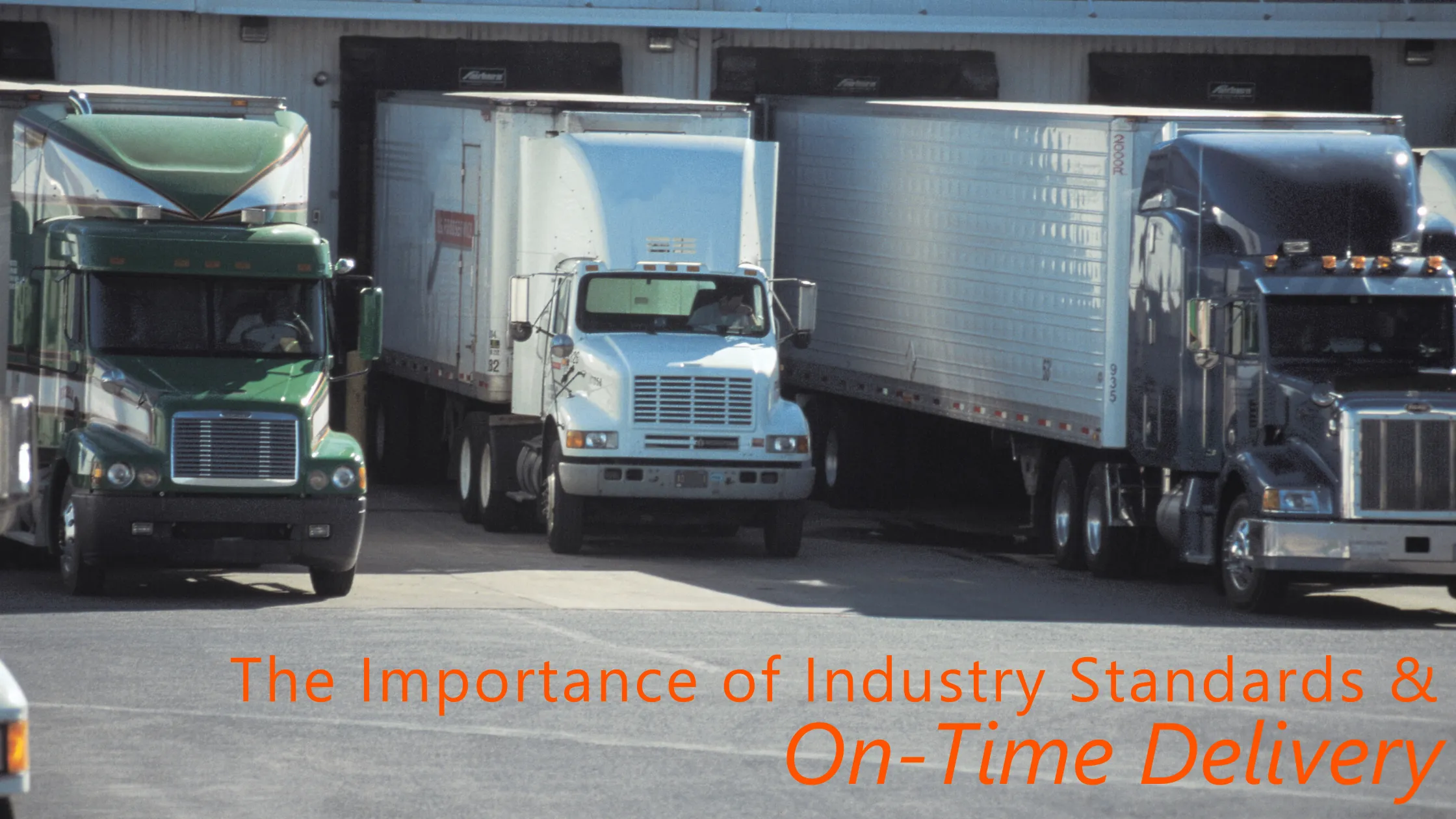
As industry giants like Walmart and Amazon respond to rising consumer demand for instant shipments with free one-day shipping and same-day delivery options, the delivery window for suppliers and logistics providers is growing smaller and smaller. With less time to meet these quicker delivery benchmarks and generally tighter regulatory guidelines for carriers, manufacturers are facing some serious pressure to perform.
Table of Contents:
-
-
-
-
-
-
-
Importance of OTD Trucking
The “Amazon Effect” of customers wanting faster and more precise delivery seems to have completely crossed over from the B2C to the B2B world, too. For example, Walmart’s new “on-time, in-full program” requires suppliers to show up on schedule with 97.5 percent of a food and beverage order in their trailer, according to a recent Transport Topics article.
While many other big-box retailers also typically require a 95 percent minimum on-time performance from their suppliers, industry averages for prepaid full truckload and less-than-truckload shipments fall a little lower at 87 and 70 percent, respectively. Despite these averages, retailers are starting to apply the expectations their customers have of them upstream to their suppliers and carriers when it comes to delivery service.
To further put things into perspective for shippers, these on-time minimums are only going to shrink. And based on the current trends, it’s reasonable to expect the 95 percent requirement to become the minimum standard for delivery orders within the next five years, not only for these large retailers but also across most parts of the supply chain industry.
At this point, the industry giants are coming down hard on delivery requirements as a way to deal with shifts in consumer buying patterns. So, as consumers reap the rewards of these new norms, everyone upstream (manufacturers and logistics service companies included) needs to adjust quickly in order to keep up with demand and meet the vendor scorecard KPIs of customers.
Because issues like late deliveries create inefficiencies during the fulfillment process and delays for retailers (especially those relying on just-in-time inventory models), frequent mistakes can add up pretty quickly. When suppliers fail to comply with retailer requirements, the resulting fines, or chargebacks, can lead to losses in revenue that equal tens of thousands of dollars per shipment. If you want to avoid costly chargebacks and boost business, it’s important to focus on raising and maintaining a consistent on-time delivery, or OTD, percentage.
In addition to avoiding the costly penalties of charge backs, it’s important to maintain OTD performance because it strengthens partnerships and encourages customer loyalty. Being dependable to deliver on time not only helps your partner’s succeed but it helps you set and meet expectations with your customers.
HOW TO IMPROVE OTD PERFORMANCE
1. Gain Access to Better Technology
A high level of delivery performance is no accident. So, shippers need to have a plan in place to achieve a 95 percent on-time delivery standard in the long term with consistency and efficiency. Logistics technology helps shippers plan, manage and select carrier rates, and maintain visibility of the status of shipments.
Now is the time for businesses to either invest in a top-of-the-line logistics technology platform or turn to a leading logistics service provider, that has already made those investments. When choosing the latter, it’s important for shippers to find a partner who offers relevant industry expertise, has an extensive carrier network, effectively communicates, and integrates forward-thinking strategies by maximizing the use of their technology.
2. Consolidate Your Freight
Another method shippers can use to respond to changing industry standards and increase OTD rates is by consolidating freight. Combining several smaller shipments into one full truckload allows carriers to avoid empty miles and helps shippers save money, while still satisfying retailer on-time minimums. The ability to consolidate orders efficiently is another benefit of warehousing technology.
Aside from quicker delivery times, freight consolidation in warehousing space also calls for fewer touches, which decreases the chances of your product being damaged in transit and provides a more sustainable alternative to unnecessary LTL shipments out of distribution centers.
3. Improve Supply Chain Relationships
Although technology and working with best-in-class delivery partners will play a large role in maximizing supply chain efficiency, it’s also equally important for companies to make becoming a shipper of choice a priority again. It’s already clear how solid carrier relationships can boost your company’s bottom line, so focusing your efforts on establishing trust and understanding carriers’ needs will only serve to benefit all parties involved.
On the other hand, carriers should avoid assuming that retailers are leveraging strict delivery requirements and resulting chargebacks to increase their profits or mitigate their costs. According to the CEO and founder of CaseStack Inc., Dan Sanker missed shipment fees typically only account for one percent of revenue for consumer product goods. At the end of the day, every supply chain participant should assess their needs as well as the needs of their partners and identify how they can contribute to improving the delivery experience.
BENEFITS OF INCREASING OTDS
Logistics partnerships aren’t the only relationships shippers need nurturing, however. And looking at delivery performance simply in terms of trying to avoid chargebacks is too narrow-minded. One of the first benefits of increasing OTDs is the positive effect it has on customer satisfaction.
With each delivery that shows up late, your company risks compromising consumer trust, so in order to encourage repeat business and keep customers loyal to your brand, you need to come through on your delivery promises. OTDs keep supply chains running smoothly. After all, every individual delivery usually accounts for just one step in a supply chain when you consider how products are sourced, manufactured, warehoused, and delivered to your end customers.
For example, manufacturers understand this because the reliability of deliveries ensures production lines are moving at maximum efficiency when the inbound product arrives when it is supposed to. And, late inbound materials prevent outbound orders from being completed on-time, therefore impacting inventory levels and order fulfillment everywhere downstream.
HOW TO MEASURE OTD PERFORMANCE
In simple terms, if you calculate the number of shipments you delivered on time to a customer in relation to the total number of orders that were shipped, you’ll find your basic OTD percentage. There are many OTD KPIs to measure and evaluate OTD performance, though.
Before making a calculation, it’s important to consider factors like the number of units ordered, the delivery dates, and the number of line items on the order. There are also a lot of different terms to describe dates that are involved in the shipping process, so to avoid confusion and ensure you’re on the same page as your supply chain partners, clarify what on time means exactly for everyone.
Once you’ve clearly defined and calculated your OTD percentage, you’ll need to evaluate it based on pre-established delivery benchmarks. Typically, this number can help show you how your business is currently functioning, so if the number falls below your expectations, you’ll most likely need to tackle deeper operational issues.
FINAL THOUGHTS
Don’t make the misguided assumption that late deliveries are simply unavoidable in the delivery business. And, lowering your standards in comparison to give the appearance of meeting meaningful KPIs won’t help you optimize service performance to customers.
Although it can be complicated to track OTD for shipments within a supply chain, there’s obvious value in improving this metric. Improved OTD performance will not only increase customer satisfaction, but also enhance your productivity, profits, and professional relationships. For these reasons, shippers need to focus their efforts on how they can improve OTD now if they want to jump ahead of the curve to address shifting industry standards.





